
 Baseball Pilgrimages Baseball Pilgrimages
| Frawley Stadium Info |
Directions
Seating Diagram
Tickets
Phone: 302-888-2015
Outfield Dimensions
LF: 325' CF: 400' RF: 325'
|
| Blue Rocks Info |
Level: High A
League: Carolina
Affiliate: Kansas City Royals
2017 Blue Rocks Schedule
|
| Travel Info |
Nearest Major Airport:
Philadelphia International
(22.6 miles)
Nearest Pro Ballparks:
Citizens Bank Park in Philadelphia, PA (26.9 miles)
Ripken Stadium in Aberdeen, MD (41 miles)
Clipper Magazine Stadium in Lancaster, PA (51.3 miles)
FirstEnergy Stadium in Reading, PA (60 miles)
Arm & Hammer Park in Trenton, NJ (61.9 miles)
Camden Yards in Baltimore, MD (73.3 miles)
PeoplesBank Park in York, PA (74.5 miles)
Coca-Cola Park in Allentown, PA (84.4 miles)
Prince George's Stadium in Bowie, MD (94.7 miles)
FirstEnergy Park in Lakewood, NJ (99.1 miles)
FNB Field in Harrisburg, PA (99.9 miles)
|

The Baseball Travel Map is one of many great items in our Baseball & Ballpark Store.
| Ballpark Attendance |
| Year | Total | Rank * |
2012
2011
2010
2009
2008
2007
2006
2005
2004
2003
2002
2001
2000
1999
1998
1997
1996
1995
1994
1993 |
287,992
288,738
296,041
288,084
312,375
306,430
312,258
322,287
320,788
315,134
331,545
336,074
324,019
321,143
320,540
326,201
331,562
358,486
335,024
332,132 |
3
3
2
2
1
1
1
1
1
1
1
1
1
1
1
2
2
2
2
2 |
* The Blue Rocks' total attendance ranking in the 8-team Carolina League
|
Baseball Pilgrimages
Where the pursuit of baseball never ends.
[Site Map]
|
|
The sole ballpark in the state of Delaware is sensational. Situated near the riverfront in Delaware's largest city, Wilmington's Frawley Stadium is good looking outside with great views inside. Made with texturized red-brick big blocks, the stadium overlooks the Wilmington skyline and numerous attractive buildings, many made of brick, that are nearby. The playing field and its backdrop can be viewed from the open concourse, which is at the top of the seating bowl and contains banners listing the names of Blue Rocks that became big leaguers. The team's successes (division and league titles) are posted on the baseline facades on an impressive suite level, which features a glass-walled and multi-level private club area directly behind home plate. In the same spot outside the stadium are tributes to Delaware's three Baseball Hall of Famers, each of whom were born or died in Wilmington. The placement of the tributes is fitting, since a short distance away is the double door entrance to the Delaware Sports Museum and Hall of Fame, which is a separate admission attraction built into the ballpark's first base facade. Despite all of its modern amenities and baseball history, Frawley Stadium is best known for a dancing mascot known as "Mr. Celery." He bursts onto the field following every run the home team scores, does his thing, then exits through a covered tunnel that cuts through the grandstand a couple sections removed from the Blue Rocks' dugout. Merchandise bearing the goofy green stalk is prominently featured in the roomy team shop, called The Quarry, which like just about everything else in this ideally located ballpark exceeds expectations considering the team's lower-level classification. Essentially, this is one pre-1995 minor league ballpark done right. So well done, Wilmington, as even in this day and age you're still home to one of the minors' best ballparks in the Northeast.

Location
Wilmington's ballpark is about a mile south of Wilmington's downtown in a can't miss spot alongside I-95. The Interstate is elevated, so it hovers above left field, and is so close that its roadside billboards are a rather prominent part of the ballpark's backdrop. Passenger trains are also visible from within the stadium on the tracks that are beneath I-95. While the major modes of land-based transportation are on one side, the Christina River is not too far away going the opposite direction and all the cool places located near the western banks of the river are collectively a part of what's referred to as Riverfront Wilmington. The opening of Frawley Stadium began the riverfront's revitalization, turning it from a dilapidated shipyard into "a thriving destination rich in history and filled with recreational, cultural, retail and culinary attractions." Those are the promotional words of the state's Riverfront Development Corporation and they ring true, as the site's shipyard history is richly detailed along the 1.75 mile riverwalk that ends at an urban wildlife refuge and environmental education center. Near the ballpark are the Delaware Children's Museum and Delaware Center for Contemporary Arts. Closer to it are a few stand-alone restaurants and more can be found in the waterside Shipyard Shops, which is also home to the Wilmington Rowing Center. Next to the baseball grounds is the Chase Center on the Riverfront, the city's convention center, and a four-story office building; both reborn structures date to the days that the Dravo boatyard was in operation and the names of the Word War II vessels that Dravo's workers built and launched are on the Compass Rose in the nearby Dravo Plaza, which commemorates the riverfront's long ago shipbuilding era. Furthermore, from the plaza's dock the Kalmar Nyckel sets sail. It's a replica of the 1638 ship that brought the first European settlers to the Delaware Valley. So basically there's a lot to see and do within walking distance of Frawley Stadium and there's certainly nothing minor league about its location.
Getting There [map it]
As the crow flies, the distance between I-95 and Frawley Stadium can be measured in feet. As the car drives, it's about a mile from the Interstate. Just take exit #6 and head towards the Riverfront Wilmington, which will put you onto Martin Luther King Blvd, from which you turn right onto Justison Street. (Note: The directions are slightly different depending on whether you are traveling south or north on I-95, so check the Blue Rocks' website for turn by turn details.) It's a half-mile drive on very commercially developed Justison until you reach Shipyard Drive, where you turn right and drive right into the stadium's parking lot.
Parking
All parking lots are paved and free to park in. The main lot is a big one that leads right up to the ballpark's brick-paved doorstep. It's first half-dozen rows are reserved for the handicapped and other pass holders. Just behind the outfield fence and extending from right to center field is another lot, which generally only gets used after the main one fills up.
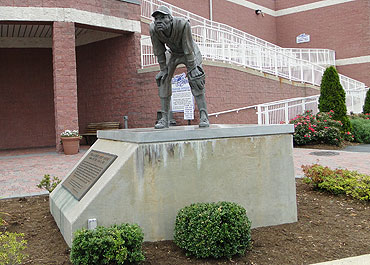 |
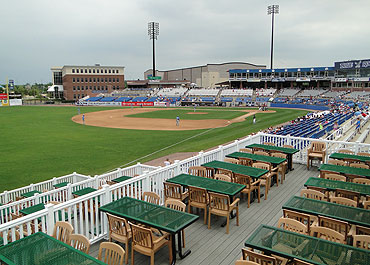 |
| A statue of Judy Johnson stands in front of the stadium, which has an attractive reddish stone block facade. Inside, each side of the grandstand has group picnic areas. The third base side picnic pavilion is bigger, but the first base side's has better views of the field. |
Features
In landscaped areas in the stadium's otherwise brick paved entry plaza are tributes to the three Delaware natives who are enshrined in Cooperstown, NY. To the left of the box office are stone markers with diamond shaped plaques honoring umpire Bill McGown and Deadball Era pitcher Vic Willis. Atop a big pedestal to the right of the box office is a statue of famed Negro Leaguer William Julius "Judy" Johnson, who was an exceptionally fine fielding third basemen. As such, his life-size statue shows him in a fielding position. The stadium's playing field is named Judy Johnson Field in his honor.
This can be considered a second story stadium, since to get to all seating fans must go up a story to get to its concourse. Both main gates are at concourse level. A staircase leads to one gate, a switchback ramp to the other. The gates are a short distance apart behind home plate.
The concourse is above all seats in the main grandstand, which has a roughly mid-level cross aisle. Below it all seating is stadium style. Seats above the aisle are a mixture of chairback seats and (mostly) bleachers with backs. The bleachers in the general admission section also have backs but they are behind the third base concourse. That makes them kind of far away but their views of the field are good and its backdrop great.
Eight suites are above the concourse down each baseline. On the facade above the first baseline suites are baseball-shaped circles listing the Blue Rocks' regular season division titles. Carolina League championships are commemorated on pennants on the facade of the third baseline suites.
Picnic pavilions are at each end of the grandstand. The left field line pavilion has four tiers of picnic table seating and a capacity of 215 people. Capable of holding 125 people, the right field line deck contains just two levels of tables but you can actually see the game from them, which isn't the case from their third base side counterparts. Each area has the same style of picnic tables (made of hard rubber) and plastic deck chairs.
Two former Blue Rocks players have had their numbers retired by the team: Robin Roberts (#36) and Mike Sweeney (#33). Roberts was a Blue Rock in 1948, Sweeney in 1995. Their numbers are displayed on markers above the outfield fence. The team also honored their original public address announcer, John McAdams, with an outfield memorial that shows a microphone above the words 871 games, which is how many games McAdams manned the mic for the Blue Rocks before he died in his sleep on June 16, 2005 at the age of 64. McAdams' memorial debuted exactly one year after his death, while Roberts' number was retired in 1998 and Sweeney's in 2004.
Banners hanging from the third base concourse list many of the "Blue Rocks in the Show," done so by year. For example, the 1997 banner lists Jose Santiago, Carlos Febles, Scott Mullen, Carlos Beltran, Mark Quinn and Matt Treanor, all of whom played in Wilmington in '97 and in the major leagues in later years.
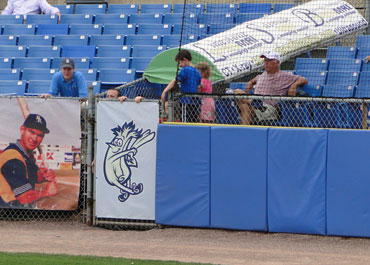 |
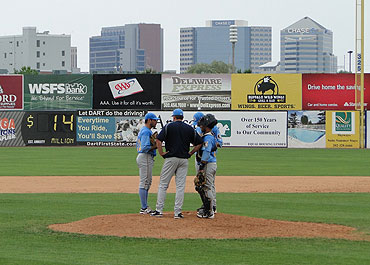 |
| He only appears when the Blue Rocks score a run, but images of Mr. Celery can be found throughout Frawley Stadium, including upon the gate through which the dancing mascot enters the field. The Wilmington skyline always looms large beyond right field. |
Frawley Stadium Facts, Figures & Footnotes
Construction cost: $6.1 million
Financing: The State of Delaware (63.9%) and City of Wilmington (36.1%) unequally split the cost: the state's tab was $3.9 million and Wilmington's was $2.2 million
Architect: Trish England of Design Exchange
Construction manager: Minker Construction Inc.
Groundbreaking took place on November 1, 1992.
Built on 5-acres of land just west of the Christina River that was once the site of the Dravo shipyard, where thousands of workers built landing ships and destroyer escorts that were vital to the Allies' victory in World War II.
Had a capacity of 5,537, a different address (801 South Madison Street) and no official name when it opened. When a name was finally chosen, Legends Stadium was selected as a tribute to all Delaware natives who had excelled in professional baseball.
Was officially dedicated as Daniel S. Frawley Stadium on September 1, 1994 in honor of the former two-term mayor of Wilmington who died unexpectedly at the age of 50 on February 2, 1994. Frawley was the city's mayor from 1985-1993 and his last major accomplishment in office was the deal that brought minor league baseball back to Wilmington. Although the formal dedication occurred later, the name Frawley Stadium was announced about two weeks after his death and was used throughout the 1994 season.
The playing field is named in honor of Judy Johnson, a longtime Delaware resident and Negro League legend who was inducted into the Baseball Hall of Fame in 1975. Johnson was considered the "best third baseman of his day" in the Negro Leagues, according to his plaque in Cooperstown, and died in Wilmington in 1989.
Owned by the Delaware Stadium Corporation, which has its offices on ground level, adjacent to the box office. Operated and maintained by the Wilmington Blue Rocks.
A small stadium expansion project was completed in 1994 (about 250 seats were added) and a much larger one, finished in time for the 2001 season, added more seats and created space for the Delaware Sports Museum and Hall of Fame, which opened on site in June 2002. The Delaware Hall had existed since 1976 but Frawley Stadium is its first permanent home. The entrance to its 5,000-square-feet of exhibit space is at street level on the stadium's first base side.
Has 16 luxury suites. Each suite has 12 outdoor balcony seats and a capacity of 20 people.
Mr. Celery has been a stadium staple since the 2000 season. The concept to have a mascot of some sort celebrate Blue Rocks runs is based on Lake Elsinore's pink "RBI rabbit," who emerges from the right field scoreboard to dance on the warning track when the hometown Storm score a run. A celery stalk became the chosen dancing mascot in Wilmington merely because such a costume had been left behind from a previous promotion.
Prior to its construction, Wilmington's only foray into professional baseball was from 1940 through 1952, when the original Blue Rocks played at Wilmington Park, which cost $185,000 to build and stood at 30th Street and Governor Printz Boulevard until it was razed in 1963. The name Blue Rocks was originally selected in a name-the-team contest staged by the Wilmington Evening Journal. Robert Miller came up with the winning entry, with the blue-tinted granite found alongside the local Brandywine River being the inspiration for the name Blue Rocks.
Was named the 4th most vegetarian-friendly minor league ballpark in 2012 by PETA.
Official Ballpark Firsts
First game: On April 17, 1993, the Wilmington Blue Rocks beat the Winston-Salem Spirits, 6-5, in front of 5,288 fans in Game 1 of a doubleheader. Wilmington also won the second game, 4-1, and it drew a crowd of 4,792. The stadium officially opened with a day-night, separate admission doubleheader because its original opener, scheduled for April 16, 1993, was postponed due to rain.
Three ceremonial first pitches were thrown, the final one by Robin Roberts, who embarked on his Hall of Fame pitching career in Wilmington with the original Blue Rocks, for whom he appeared in 11 games in 1948 before getting called up to Philadelphia. The other ceremonial pitches that proceeded Roberts' were tossed by Wilmington Mayor James H. Sills Jr. and U.S. Rep. Michael N. Castle.
Other official ballpark firsts (all of which occurred on 4/17/93, unless noted):
| Pitch | Batter | Hit (single) | Home Run (4/19) | Winning Pitcher | Losing Pitcher | Save |
| Jon Lieber | Eric Owens | Bobby Perna | Joe Calder | Roger Landress | John Hrusovsky | Chris Eddy |
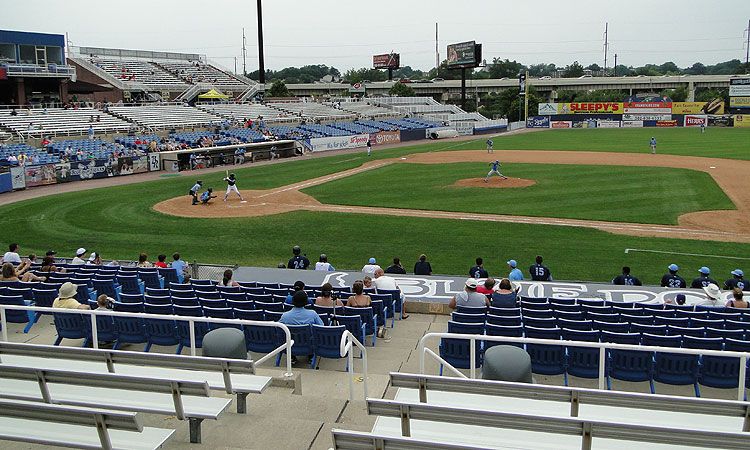
|










